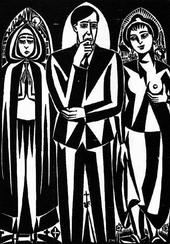in memory of Frans Masereel
The painter and graphic artist Frans Masereel, born in the Belgian Blankenberghe in 1889, moved to Gent in 1896, where he began to study at the Ecole des Beaux-Arts at the class of Jean Delvin at the age of 18. In 1909 he went on trips to England and Germany, which inspired him to first etchings and woodcuts. From 1911 on Masereel settled in Paris for four years and then he emigrated to Switzerland, where he worked as a graphic artist for various journals and magazines. The woodcut series, mainly of sociocritical content and of expressionistic form concept, made Masereel internationally known. Among theses were the so-called image novels like ‚Passion eines Menschen', ‚Mein Stundenbuch', ‚Die Sonne', ‚Die Idee' and ‚Geschichte ohne Worte', which dated all from c. 1920. At that time Masereel also drew illustrations for famous works of world literature by Thomas Mann, Emile Zola and Stefan Zweig. In 1921 the artist returned to Paris, were his famous street scenes, the Montmartre-paintings, came into existence. Since 1925 he lived near Boulogne-sur-Mer, where he painted predominantly coast areas, harbour views as well as portraits of sailors and fishermen. During the 1930s the number of illustrated books and single woodcuts decreased. In 1940 the artist fled from Paris and lived in several cities in Southern France. At the end of world war II Masereel was able to resume his resting artistic work and produced woodcuts and paintings. Since 1946 he worked for several years as a teacher at the "Centre des Métiers d'Art" in Saarbrücken. In 1949 Masereel settled in Nizza. In the following years until 1968 several series of woodcuts were published, which differ from his earlier ‚novels in picture' in basing on variations of a subject instead of being a continuing narrative. Furthermore he designed decorations and costumes for numerous theatre productions. The artist was honoured in numerous exhibitions and became a member of several academies. Frans Masereel was entombed in Gent.
